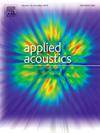Study on the formation and sound absorption properties of multi-layer woven fabrics with air layers
IF 3.4
2区 物理与天体物理
Q1 ACOUSTICS
引用次数: 0
Abstract
Textile porous materials, due to their lightweight, flexibility, and strong designability, have shown great potential for application in sound absorption. Using polyester yarns as warp and weft yarns, the multi-layer air-layer woven fabric was successfully prepared using the ’flattening-weaving-restoring’ method. By dividing the weaving area and controlling the density of warp and weft yarns, multi-layer air-layer woven fabrics with different numbers of layers, pore sizes, and tightness were produced. The sound absorption coefficient evaluation results indicate that the multi-layer air gap design and high fabric tightness effectively improved the sound absorption coefficient within the mid-frequency range of 1000–5000 Hz. Under high fabric tightness, increasing the pore size can further enhance the sound-absorbing effect of the fabric. Using the sound absorption coefficient as the response value, a three-factor, three-level response surface analysis method was employed to establish a quadratic regression equation and recommend the optimal parameter combination. Impedance tube testing and response surface analysis revealed that when the fabric structural parameters were optimized to a tightness of 105 % and a pore size of 7 mm, the four-layer air-layer fabric exhibited outstanding broadband sound absorption performance, with an average sound absorption coefficient of 0.4827 across six octave bands, significantly surpassing the acoustic performance of conventional woven fabrics.
带空气层的多层机织物的形成及吸声性能研究
纺织多孔材料以其轻量化、柔韧性强、可设计性强等优点,在吸声领域显示出巨大的应用潜力。以涤纶纱为经纬纱,采用“平整-织造-复原”的方法成功制备了多层空气层机织物。通过划分织造面积,控制经纬纱密度,可制得不同层数、孔径、紧度的多层空气层机织物。吸声系数评价结果表明,多层气隙设计和织物的高密闭性有效地提高了1000 ~ 5000 Hz中频范围内的吸声系数。在织物密闭性较高的情况下,增大孔径可以进一步增强织物的吸音效果。以吸声系数为响应值,采用三因素三水平响应面分析法,建立二次回归方程,并推荐最优参数组合。阻抗管测试和响应面分析表明,当织物结构参数优化为紧密度为105%,孔径为7 mm时,四层空气层织物具有出色的宽带吸声性能,6个倍频带的平均吸声系数为0.4827,显著优于传统机织物的吸声性能。
本文章由计算机程序翻译,如有差异,请以英文原文为准。
求助全文
约1分钟内获得全文
求助全文
来源期刊

Applied Acoustics
物理-声学
CiteScore
7.40
自引率
11.80%
发文量
618
审稿时长
7.5 months
期刊介绍:
Since its launch in 1968, Applied Acoustics has been publishing high quality research papers providing state-of-the-art coverage of research findings for engineers and scientists involved in applications of acoustics in the widest sense.
Applied Acoustics looks not only at recent developments in the understanding of acoustics but also at ways of exploiting that understanding. The Journal aims to encourage the exchange of practical experience through publication and in so doing creates a fund of technological information that can be used for solving related problems. The presentation of information in graphical or tabular form is especially encouraged. If a report of a mathematical development is a necessary part of a paper it is important to ensure that it is there only as an integral part of a practical solution to a problem and is supported by data. Applied Acoustics encourages the exchange of practical experience in the following ways: • Complete Papers • Short Technical Notes • Review Articles; and thereby provides a wealth of technological information that can be used to solve related problems.
Manuscripts that address all fields of applications of acoustics ranging from medicine and NDT to the environment and buildings are welcome.
 求助内容:
求助内容: 应助结果提醒方式:
应助结果提醒方式:


